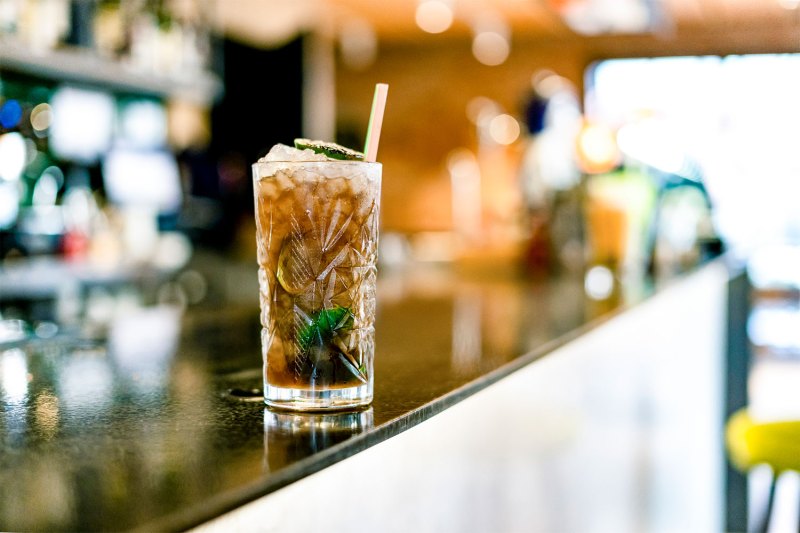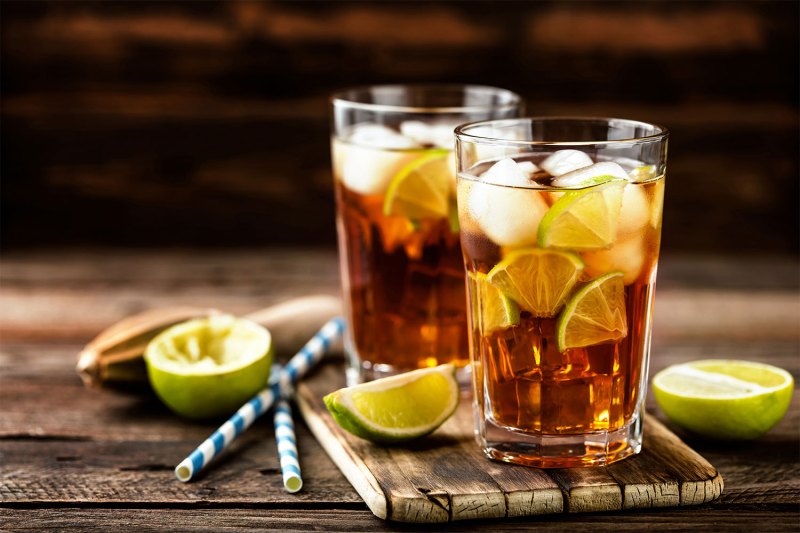It’s a rare person who can point to an intricately crafted, top-shelf cocktail and claim that such a lofty libation was their first-ever mixed drink. For many of us (in fact, I’d venture to say “for most of us”), our earliest encounters with cocktails involved haphazard blends of cheap booze, whatever juices or sodas we had on hand, and little regard for flavor balance or nuance. Examples that come to mind include jungle juice, wildly spirit-heavy Jack and Cokes or Screwdrivers … and, of course, the notorious Long Island Iced Tea.
Allegedly invented in the 1970s in its namesake region of New York, the Long Island Iced Tea (or “LIIT”) consists of (roughly) equal parts vodka, tequila, rum, and gin, with a slightly-lesser quantity of triple sec and a splash of cola to top it off. The last ingredient lends the drink a light brown hue somewhat similar to that of iced tea (hence the name). Sounds like a surefire hangover in a glass, right? Generally speaking, you’d be right — which is why the LIIT tends to be most popular among youthful drinkers whose systems can handle a dervish of high-proof spirits all mixed together.
Although the Long Island Iced Tea has a (well-deserved) reputation as a quick way to get drunk and a bad idea for anyone seeking a flavor-forward, “grown-up” drinking experience, this beverage continues to show up on bar menus with some regularity, leading us to wonder: Can the Long Island Iced Tea still be redeemed and revamped as a cocktail with substance rather than as a college-rager staple? We asked a group of past and present bartenders for their thoughts on this controversial drink, and we collected an assortment of professional opinions, both pro- and anti-LIIT.
Let’s start with the naysayers:
The Long Island Iced Tea has some nostalgia value, but some bartenders question whether that justifies its place on a beverage menu.
“In these unprecedented times, perhaps folks are defaulting to not [only] comfort food, but [also to] comfort drinks,” suggests veteran NYC bartender (and award-winning competitive eater) Crazy Legs Conti. He cautions imbibers against allowing the fond memories of their past drinking days to cloud their judgment where the Long Island Iced Tea is concerned:

“The Long Island Iced Tea is an oft-remembered cocktail from [our] wisely misspent youths. Can it be ‘saved’? Not a chance — unless you are actually a sixteen year old, seeking the headache-inducing, hangover-ready ‘bouillabaisse’ of rail liquor. The drink reminds me of the beer ad where their beer is claimed to be “better than all others combined,” and then the commercial guy pours all the others beers into a bucket and quaffs. The Long Island Iced Tea is proof that the sum can be much more puke-inducing than the parts.”
Want a drink with a high ABV that doesn’t remind you of a frat party? Opt for a tiki cocktail instead of an LIIT.
It’s a truth universally acknowledged that no one drinks a Long Island Iced Tea for its satisfying depth of flavor. Its appeal (and its danger) rests in its potency, but even if a stiff drink counts as your top priority, Rocco Milano, a former Denver bartender and the founder of On The Rocks canned cocktails, wants to remind you that you have options that extend beyond the Long Island Iced Tea. Namely, tiki cocktails.
“The long Island Iced Tea is past its prime! If you study classic tiki cocktails, you can find an amazing collection of drinks that pack every bit as much punch [as Long Island Iced Teas], but still pay attention to balance, unique flavors, and [the] use [of] fun ingredients. The Tropical Itch, the Suffering Bastard, and the Zombie [are] examples [of tiki
If you don’t want to give up on the Long Island Iced Tea but do want to class up the joint a bit, then you’re in luck. We also chatted with a few bartenders who believe that the LIIT isn’t beyond redemption, and they provided the following ideas for transforming this bottom-shelf standard into a not-so-guilty cocktail pleasure:
A bit of standardization would go a long way toward elevating the Long Island Iced Tea’s reputation.
One of the greatest mysteries of the LIIT involves the fact that measurements aren’t really considered when building this drink. It’s an improvisational cocktail by nature, but former Hilton bartender and current nutrition coach Elliott Reimers of Rave Reviews thinks that the Long Island Iced Tea could benefit from a few rules and guidelines.
“Whoever thinks that Long Island Iced Teas are dying maybe hasn’t had one made correctly. For me, it’s one of the few cocktails that pack in a variety of flavors. It’s sweet, sour, and bitter all at once. The danger of the LIIT is that different bars make them in [different] ways, and that confuses the drinker. I’ve been served Long Islands in short glasses, long glasses. and even in metal cups. If you do not know how much [alcohol] you are getting, you will stop ordering, and that seems to be the case for this drink. So maybe we need to standardize the way we prepare this delicious cocktail, and [then] we’ll see an increase in orders, I really hope so,” Reimers muses.
High-quality spirits and a few subtle ingredient swaps give the LIIT an upscale makeover.
“For me, I think the only way to ‘save’ the LIIT and redeem the cocktail from its frat-party reputation is to use well-made spirits as your base as opposed to the cheap plastic handles you used to buy in college,” advises beverage director Nikki McCutcheon of Moxy Hotels in NYC. “Personally, the thought of gin and tequila together makes me cringe! However, if you use a more citrus-forward gin [rather than an overly-floral version] and a slightly-aged tequila that’s a bit more mellow, [then] you might form a union that’s a bit easier to swallow – literally. The bottom line is that if you put thought into the ingredients you are using and what they are contributing to the overall cocktail, the end result is going to be much more enjoyable (and [will] increase its perceived value on a menu) than something you’re just grabbing at random from your well.”
David English, the director of project development of Carson Kitchen in Las Vegas, agrees with the importance of trading out cheap rail liquors in favor of higher-end bottles to create a more up-market Long Island Iced Tea. He also favors changing the LIIT’s typical spirit styles, explaining that “a LIIT can be updated to a modern take by swapping the rum for cachaça to increase the depth of flavor and switching out the triple sec for a less sweet orange liqueur, like dry Curaçao. The addition of honey instead of simple syrup will allow all the elements to really meld and enrich the palate flavor.” In terms of the Long Island Iced Tea’s traditional soda topper, English recommends using a natural cola rather than the standard Coke or Pepsi, giving a particular shout-out to “Fever Tree Madagascan Cola. [It] is made with real kola bark and has a far superior flavor to your traditional brand-name colas.”
The addition of actual iced tea can offer the LIIT some balance and flavor benefits.
As we mentioned previously, Long Island Iced Teas get their name from their distinctive light-brown color rather than from the inclusion of any actual “tea.” However, owner/manager Ray Morrone of The Liquor Store in Portland, OR sees plenty of potential for a Long Island Iced Tea derivative that contains some of the real stuff.
“When someone orders a Long Island Iced Tea, most bartenders will ask to see the guest’s ID a second time, just to make sure they are of legal drinking age. But The Long Island Iced Tea does have some valuable name recognition, and bartenders could have some fun with it. The traditional recipe is supposed to mirror the look and taste of iced tea while masking the taste of the booze.With this in mind, many bartenders stopped adding tequila in the traditional cocktail recipe, since tequila overpowers the more neutral spirits like vodka, gin and white rum.
But why not have fun and use actual tea? The Oolong-hai is a Japanese cocktail that mixes a neutral spirit like shochu or vodka and an earthy, refreshing iced tea like Oolong or Sencha tea. Add a dash of lemon juice and a bit of simple syrup and you’re all set,” Morrone tells The Manual.
Editors' Recommendations
- The best tea cocktail recipes if you love a hot toddy
- The 7 Best Cocktail Shakers to Mix With in 2022
- How to Make the Best Version of the Comforting Hot Toddy
- 8 Best Rums for Making Piña Coladas Delicious
- The 10 Best Ice Cream Cocktails for Chilling Out at Home



